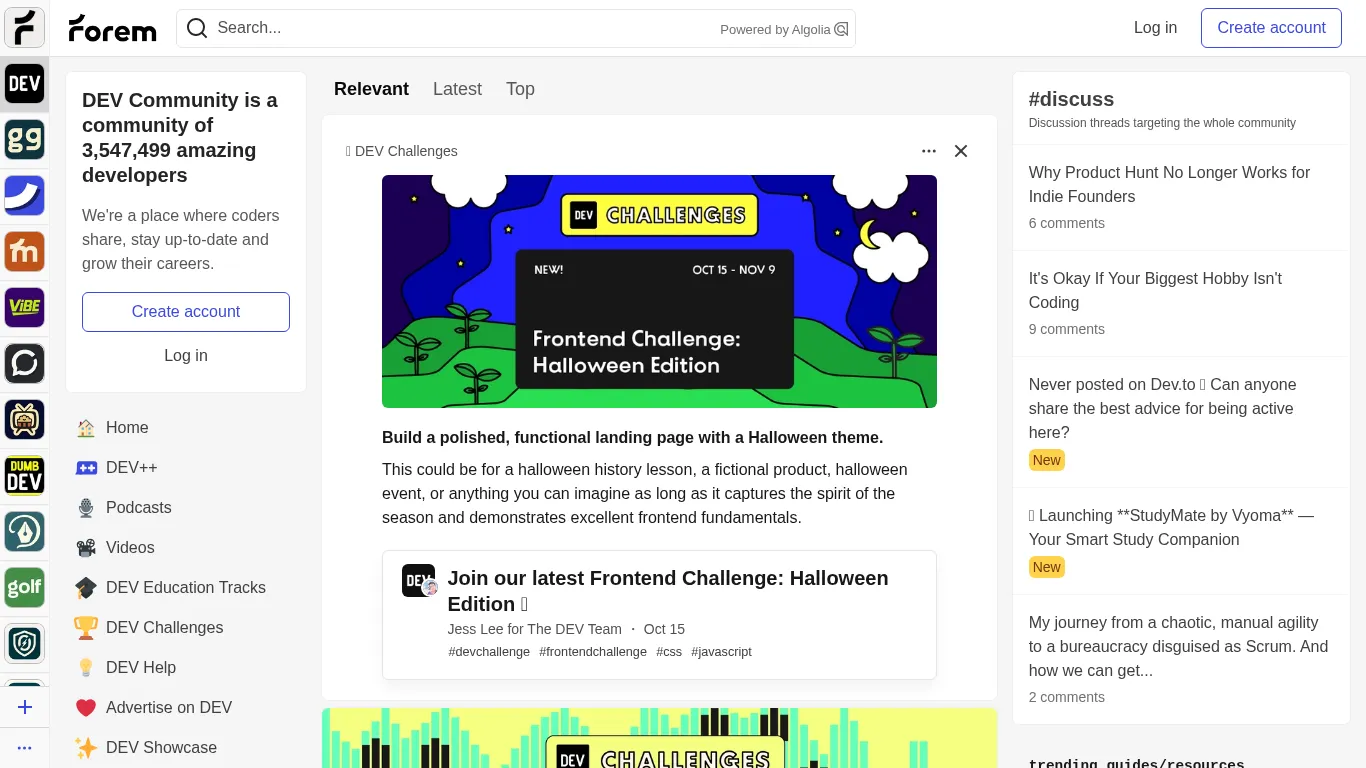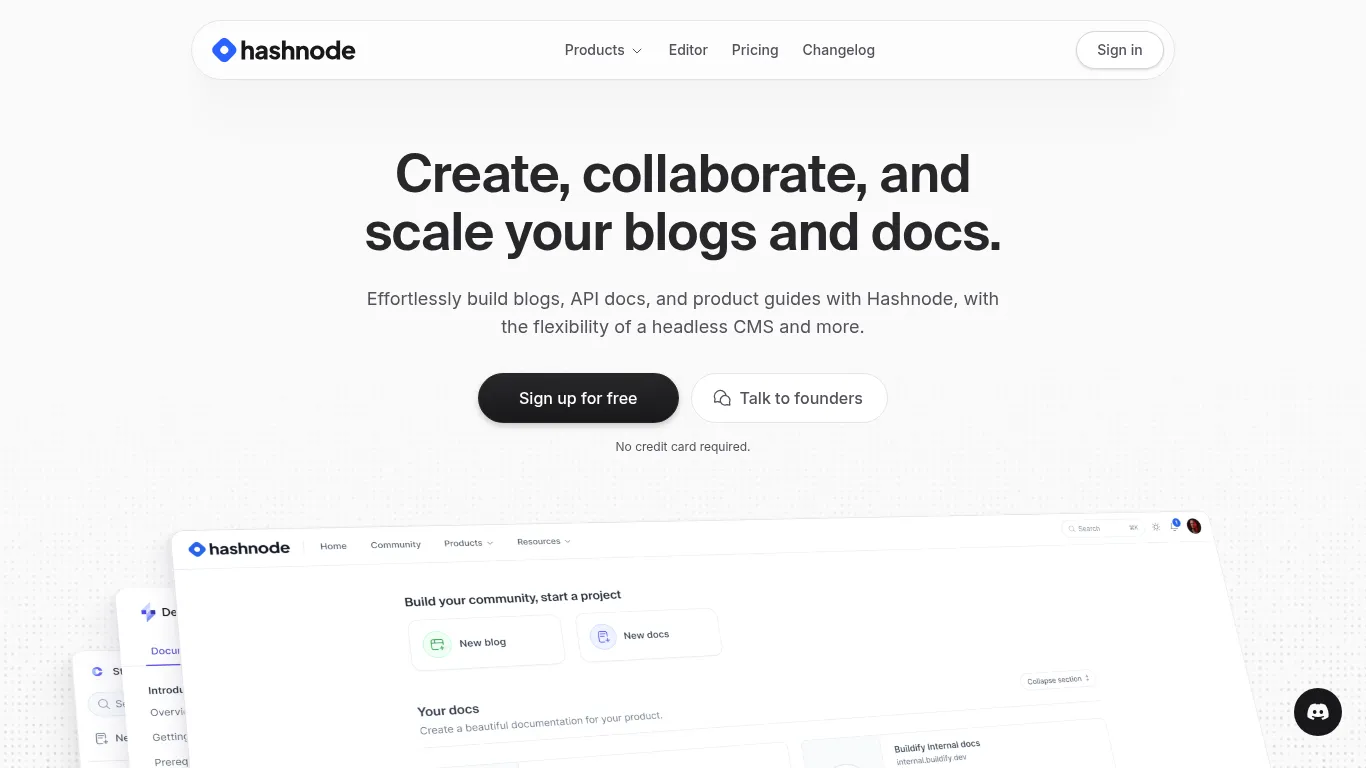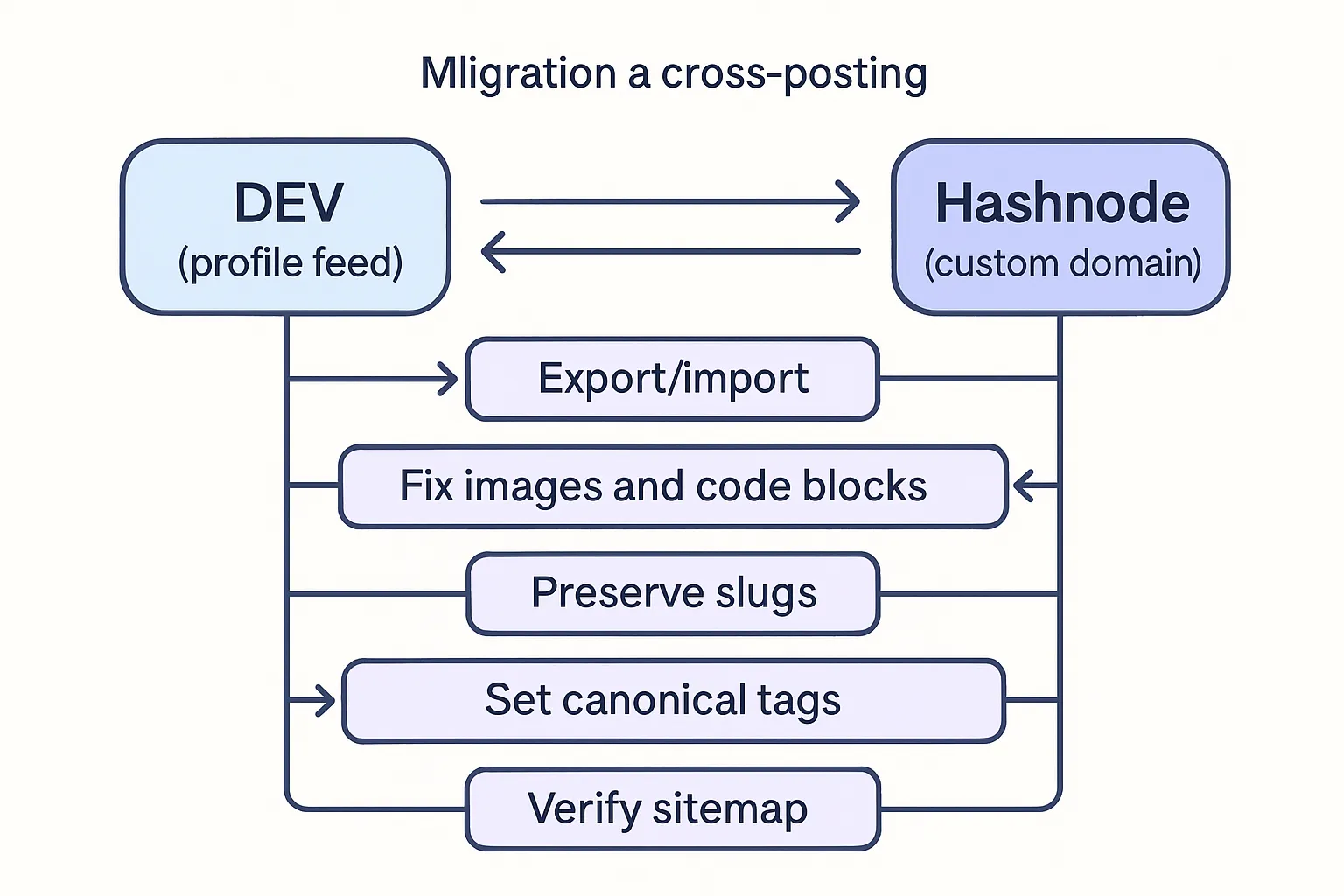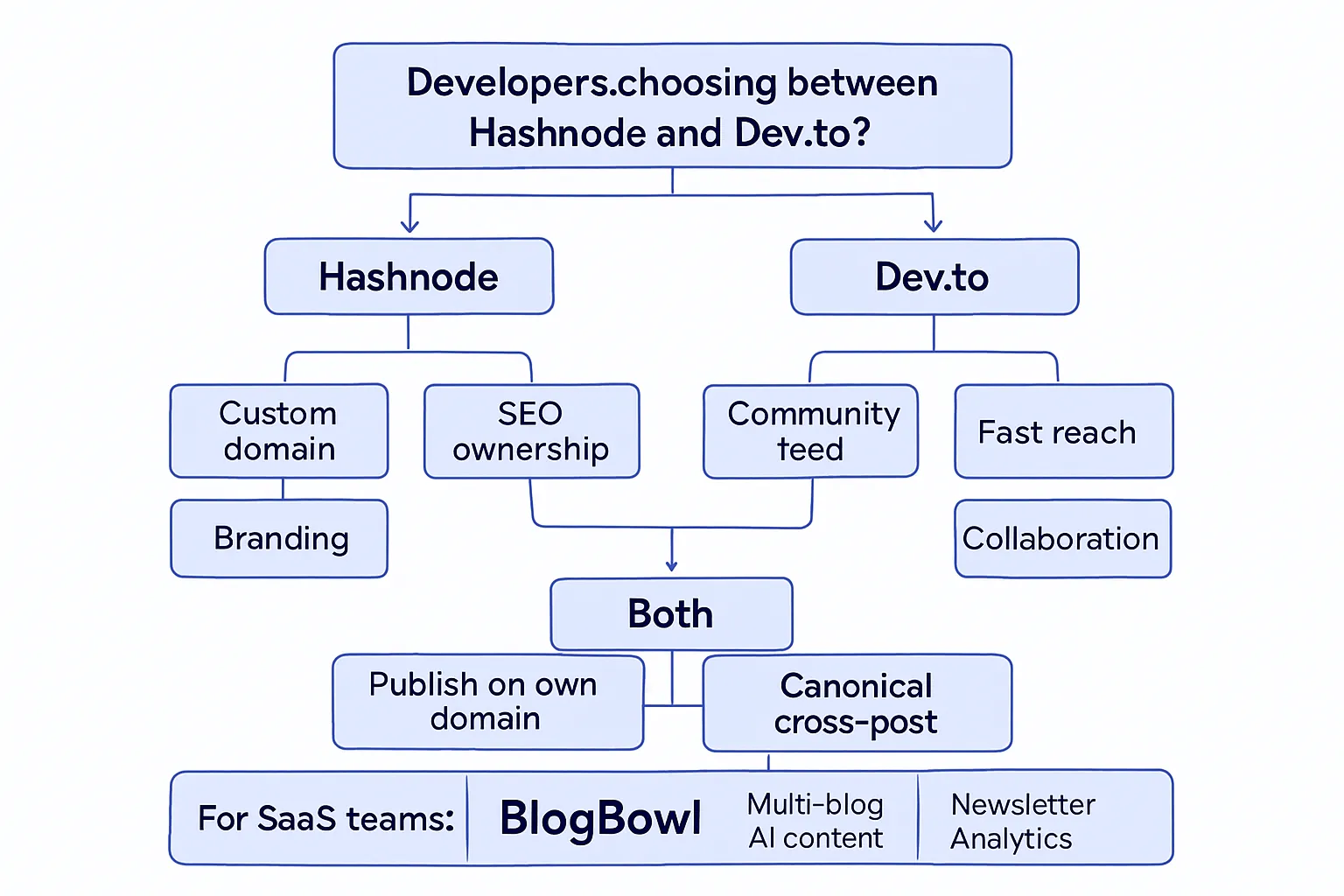Introduction
Choosing between Hashnode and Dev.to in 2025? This quick, practical coding blog comparison breaks down the essentials so developers don’t waste time trialing both. We focus on what matters most to individual developers, technical writers, and startup engineers choosing a developer blogging platform that fits their goals.
What this comparison covers and who should read it
Who it’s for: Individual developers, indie hackers, technical writers, and dev advocates evaluating Hashnode vs Dev.to for technical blogging and portfolio-building.
What we cover: Editor experience, community reach, customization and branding, SEO, monetization, integrations, and migration ease - everything you’d expect from a balanced Hashnode review and Dev.to analysis.
One-sentence takeaway on the core difference
If you want ownership and a custom domain, go with Hashnode; if you want a broader community feed and built-in social reach, go with Dev.to.
How we evaluated
Editor UX and publishing workflow
Community size, engagement, and discoverability
SEO controls and long-term content ownership
Monetization options
Integrations (e.g., GitHub) and extensibility
Ease of migration and cross-posting
Comparison at a glance
Criteria | Hashnode | Dev.to |
|---|---|---|
Content ownership & domain | Strong ownership with custom domain and sub-path options | Posts live on the platform’s domain; great for network reach |
Community reach | Targeted developer audience with distribution across the network | Massive, active community and feed-based discovery |
Customization & branding | Higher control; personal domain and styling help build a brand | Limited branding; content primarily within the DEV ecosystem |
Editor UX | Modern Markdown/WYSIWYG editor with code-friendly features | Clean writing experience; straightforward for quick publishing |
SEO controls | Stronger SEO posture via own domain, clean URLs, sitemaps | Rides high domain authority; fewer brand-owned SEO benefits |
Monetization | Reader support options; brand-building via owned domain | Sponsorships and community-driven exposure for partners |
Integrations | Developer-focused integrations (e.g., GitHub) | Community tools, tags, and series for discoverability |
Migration / cross-posting | Import tools and simple domain mapping | Easy to start; cross-posting is common in the community |
Best for | Developers who want to own and grow a branded blog | Developers who want fast visibility inside a big community |
Note on alternatives for company blogs
If you’re evaluating platforms for a company blog or SaaS content hub (not just a personal dev blog), consider a dedicated, SEO-first solution like BlogBowl. It launches a full blog, newsletter, and analytics in under 60 seconds, with AI-driven content automation that scales for teams. Learn more at https://www.blogbowl.io.
Platform overview
Dev.to (aka DEV)
DEV is a community-first publishing network for developers, built on the open-source Forem platform. It functions like a social feed for engineering content - where tagging, discussions, reactions, and curation drive discoverability. Writers publish quickly, reach a large developer audience, and benefit from the conversation that follows.
Typical use cases and audience fit
New or experienced devs seeking fast reach and feedback
Engineering leaders and advocates sharing announcements or opinions
Tutorial and career-content creators who want immediate distribution
Teams cross-posting from their main blogs to extend reach

"DEV Community saw about 7.77 million visits in September 2025." - Source
Hashnode
Hashnode is a developer-focused blogging platform that lets you publish under a free custom domain while distributing your posts across the Hashnode network. It blends personal-site ownership with network effects, offering a Markdown/WYSIWYG editor, strong technical formatting, and developer-friendly features.
Typical use cases and audience fit
Developers building a personal brand under their own domain
Indie hackers and tech writers who want both ownership and network distribution
Teams hosting engineering blogs or docs while keeping brand control
Writers who care about long-term SEO equity on their own URL

"Hashnode grew from 100,000 to 1 million monthly active users in a year, hosting 60,000 active blogs." - Source
Positioning in 2025
Choose community-first distribution (DEV) when you want immediate reach, conversation, and discovery via a massive feed - great for tutorials, hot takes, and community engagement.
Choose personal brand/site ownership (Hashnode) when you want your content on your own domain, stronger long-term SEO benefits, and a branded blog that still taps into a developer network.
Short pros/cons snapshot
DEV (community-first)
Pros: Fast reach, active discussions, easy publishing, tag-driven discovery
Cons: Limited branding/domain ownership, content lives primarily on the platform
Hashnode (owned site + network)
Pros: Free custom domain, better brand control, strong editor and code support, network distribution
Cons: Slightly more setup thought for branding; reach depends on both your domain and the Hashnode network
Writing and publishing experience
Editor UX
Markdown support, code blocks, and embeds
Both Hashnode and Dev.to support Markdown with fenced code blocks, syntax highlighting, and common dev embeds (e.g., GitHub gists, CodePen, YouTube). Hashnode adds a modern, block-based WYSIWYG Markdown editor that feels closer to a document editor, while DEV keeps the editor intentionally minimal so you can focus on text and tags.
Drafts, scheduled posts, series, collaboration
Drafts: Both platforms save drafts and support quick previews.
Scheduling: Both allow scheduling posts for a future date/time.
Series/collections: DEV’s “Series” feature is straightforward for multi-part tutorials; Hashnode offers series/collections to group related posts.
Collaboration: DEV supports collaborative drafting so multiple people can co-edit or review before publishing. Hashnode supports team collaboration with inline comments and real-time editing on team publications.
Publications (Hashnode)
Hashnode’s publication model lets individuals or teams run a branded blog with shared authorship and editorial workflows while retaining ownership through a custom domain or sub-path.
Workflow speed
Idea to publish
DEV: Ultra-fast. Open the editor, paste Markdown, add tags, hit publish. Perfect for quick tutorials, opinion posts, and community-focused content.
Hashnode: Fast once set up. If you’ve mapped a custom domain/sub-path, you get the best of both worlds - ownership plus network distribution. The block editor and built-in AI writing helpers streamline drafting, formatting, and polishing.
Mobile-friendly writing/publishing
Both platforms are mobile-friendly for editing quick updates, tagging, and publishing on the go. Long-form drafting still feels best on desktop, but mobile workflows are reliable for final checks and quick releases.
Content management
Tags, categories, series/collections
DEV: Tag-driven discovery; tags power topic feeds and recommendations. Series organizes multi-part content for easier navigation.
Hashnode: Uses tags plus series/collections to structure a blog like a personal site. This hybrid approach (owned domain + tags) supports both search and on-platform discovery.
Post updates and versioning
Both platforms let you update posts post-publication, refresh metadata, and keep content current. Hashnode’s publication-style workflow helps teams manage edits, reviews, and consistency across posts.
Search and discoverability
DEV: Strong feed and tag-based discovery inside the community; posts can trend quickly via reactions and comments.
Hashnode: Search works across your owned blog and the Hashnode network; your domain benefits from long-term SEO compounding while still reaching the developer audience through the network.
Customization, domain, and content ownership
Domain and branding
Hashnode’s free custom domain mapping vs DEV’s profile-based publishing
Hashnode lets you publish under your own domain or sub-path at no extra cost, so every article strengthens your site’s brand and SEO signals.
DEV publishes under your profile within the community domain, prioritizing network reach over personal domain authority.
Visual customization, theme options, and layout constraints
Hashnode offers configurable themes, typography, colors, and layout choices suited to a branded personal or team blog.
DEV keeps a consistent, community-first layout with limited styling control; your profile and posts look and feel like the rest of the network.

Content ownership and portability
Hosting and control
Hashnode hosts your content, but because it lives on your domain, you retain stronger control over URLs, branding, and long-term discoverability.
DEV hosts posts on the platform’s domain; you can export and cross-post, but canonical authority accrues to the network unless you manage canonicals carefully.
Export options, backups, licensing
Both platforms support content export. Hashnode’s domain mapping and SEO settings make it easier to preserve link equity if you move later.
Always keep local backups and set canonicals when cross-posting to maintain a single source of truth.
Brand-building implications
Owning your domain compounds authority over time - backlinks, mentions, and social shares point to your brand, not a third-party profile.
For developers aiming to monetize expertise, speak at events, or grow a portfolio, your-name.dev/blog (or a company sub-path) signals professionalism and sticks in memory much better than a generic profile URL.
Community reach and distribution
Built-in audience
Distribution mechanics
Dev.to: A community-first feed where distribution is driven by tags, home feed curation, and weekly trending lists. Tag editors and community mods often surface quality posts. Followers receive notifications for new posts and series updates.
Hashnode: Hybrid distribution - your post lives on your own domain and is simultaneously discoverable across the Hashnode network via tags, topics, and publications. Editorial highlights and curated collections help high-signal pieces get extra visibility.
Getting featured/trending
Dev.to: Strong potential for “trending” if you nail topical tags and timing; engagement (reactions, saves, comments) accelerates visibility. Notifications are natively social - follows and mentions drive repeat reads.
Hashnode: Posts can be promoted through Hashnode publications and topic pages; consistent quality plus relevant tags increases inclusion in curated feeds. Authors with a consistent cadence see compounding network reach.
Engagement quality
Comment culture and moderation
Dev.to: Conversations tend to be lively and supportive, with constructive feedback on tutorials and career posts. Tag communities self-moderate; editors and mods quickly downrank spammy content.
Hashnode: Comments skew more technical and implementation-focused, especially on framework-specific or API-related content. Publication owners can moderate discussions to keep threads on-topic and helpful.
Signal vs noise for niche topics
Dev.to: Broad reach means more variance - niche posts can still pop, but you’ll rely on precise tagging and timing to avoid getting buried in higher-volume topics.
Hashnode: Niche, deeply technical posts often perform well due to tighter topic distribution and audience intent; discoverability benefits from both your domain’s SEO and network tagging.
Growth playbook
Steady readership on Dev.to
Use 4–6 precise tags (e.g., framework, language, and use case) and post when your target audience is most active.
Publish in series to encourage binge reading; reference previous parts and add a short CTA for follows.
Respond to every comment within 24 hours to keep the post circulating and build reputation in tag communities.
Steady readership on Hashnode
Map a custom domain to build long-term authority; set canonical tags if you cross-post elsewhere.
Join or create publications to widen distribution; apply consistent structure (problem, implementation, code, pitfalls, performance).
Use tags strategically (3–5 focused tags), add internal links between related posts, and refresh high-performers quarterly to keep rankings strong.
Cross-posting strategy (both)
Publish first on your owned domain (for SEO), then cross-post to the other platform with canonical links and a condensed intro. Optimize headlines per platform norms and tailor tags to each community’s taxonomy.
Maintain a consistent cadence (e.g., weekly or biweekly), and build an email or follower list so one strong post can lift future posts across networks.
For teams, establish writing guidelines (tag usage, code formatting, tone) to keep multi-author output cohesive and recognizable.
SEO and discoverability
Indexing and technical SEO
Clean URLs and sitemaps: Both platforms generate clean, shareable URLs and submit sitemaps. On an owned domain (e.g., Hashnode mapped to your domain), your sitemap boosts your site’s discoverability directly, not just the platform’s.
Canonical tags: Essential for cross-posts so search engines know the source of truth. Implement canonicals consistently to consolidate ranking signals.
Performance: Fast-loading pages improve crawl efficiency and Core Web Vitals. On an owned domain, you gain more persistent benefit from performance wins because those signals accrue to your site.
Cross-posting best practices
Use canonical_url fields
On DEV, set the canonical_url to your original post’s URL.
On Hashnode, enable canonical support when importing or cross-posting.
Publish order for compounding SEO
Publish first on your own domain to earn initial crawl, backlinks, and social embeds under your brand.
After indexing, cross-post to the other platform with a canonical back to your original. Tailor headlines and tags per platform, but keep the core body consistent.
"Use rel='canonical' to consolidate duplicate URLs so ranking signals accrue to the preferred version; it's a strong hint that helps avoid duplicate content issues." - Source
Long-term search growth
Why ownership compounds: Backlinks, mentions, and internal links continuously point to your domain, building topical authority that improves rankings across future posts.
Platform network vs your site: Publishing on a network may rank quickly due to its authority, but the equity lives with the platform. Owning the URL ensures each new link and brand mention strengthens your domain’s overall visibility.
Monetization, newsletters, and analytics
Built-in monetization
DEV: Best suited for in-post sponsorship callouts and partner links. Many authors pair DEV with third-party tools (e.g., donation pages or affiliate programs) to monetize audience interest.
Hashnode: Reader support/tips and sponsor placements are straightforward when you own the domain; publication features make it easier to showcase partners and maintain sponsor pages on your site.
Email and community
DEV: Designed around follows, notifications, and feed distribution. While you can link to an external newsletter, DEV isn’t built as a full email tool.
Hashnode: Works well with subscriber capture on your domain and publication workflows. Many creators layer in newsletters and use posting cadence to grow both on-site subscribers and network reach.
Analytics and insights
DEV: Post-level metrics (views, reactions, comments) help you spot breakout topics. For funnel depth (e.g., returning readers, conversion), most creators pair content with external analytics on their own site.
Hashnode: Native post analytics plus the advantage of your own domain, which lets you use Search Console and other analytics to see queries, backlinks, and compounding SEO performance.
Pricing overview
DEV: Free to publish; monetization relies on sponsorships and third-party services; no domain ownership.
Hashnode: Free to publish with a custom domain option; advanced team/publishing features may vary. Ownership of the URL helps long-term SEO and sponsor value.
Area | Dev.to | Hashnode | Best for |
|---|---|---|---|
Monetization | In-post sponsorships; third-party donations/affiliates | Reader support/tips; sponsorship pages on your domain; publication slots | Individuals testing sponsor fit vs creators building recurring sponsor value |
Follows + notifications; external newsletter linking | Subscriber capture on your domain; publication-style updates | Builders who want a list they control under their brand | |
Analytics | Basic post stats (views/reactions/comments) | Post analytics + domain-level SEO data via Search Console and analytics tools | Authors optimizing for long-term search and topic clusters |
Pricing | Free | Free (custom domain supported); org/team features may vary | Cost-conscious creators and teams wanting brand control |
Ownership | Content on platform profile | Content on your own URL + network distribution | Brand-building and compounding SEO on your site |
Integrations and developer-centric features
GitHub, Gists, and code embeds
Repo integration and code sharing
Dev.to: Forem’s developer-first architecture supports GitHub Gists, fenced code blocks with syntax highlighting, and liquid-style embeds for common dev tools. Ideal for quick snippet sharing or linking back to repos for full context.
Hashnode: Strong Markdown/WYSIWYG editor with robust code blocks and syntax highlighting. GitHub-friendly workflow for referencing repos and gists, plus series/collections for multi-part, code-heavy tutorials.
Practical workflow tips
Keep source Markdown and key code in a public repo; embed only the essential snippet and link to the repo for full diffs.
Use language-specific code fences for accurate highlighting and easier copy-paste for readers.
Embeds and media
Diagrams, sandboxes, and rich media
Dev.to: Supports common embeds like YouTube, Gists, CodePen/JSFiddle-style sandboxes, and social embeds (e.g., X/Twitter) for demonstration-heavy posts.
Hashnode: Handles the core dev embed set (video, gists, sandboxes) inside a modern editor, which helps maintain consistent formatting for longer, tutorial-style content.
Best practices
Prefer lightweight embeds for performance and accessibility; where possible, include plain-text code in the post body.
Provide a static image or short summary beneath sandbox/video embeds so readers understand context before interacting.
Extensibility
APIs, RSS, and automation
Dev.to: Offers an API (via Forem) for programmatic operations such as fetching posts or publishing, useful for CI-driven cross-posting and dashboards.
Hashnode: Provides import/export workflows and RSS feeds for distribution; teams often combine this with editorial pipelines and backup routines for reliability.
Import/export tools and backups
Export regularly to Markdown/JSON and keep a versioned backup in Git. This safeguards against lock-in and enables automated checks (linting, link validation).
Use canonical URLs when cross-posting to consolidate SEO signals while distributing via RSS.
Webhooks and integrations
Both platforms support distribution-friendly patterns (RSS, APIs) that plug into no-code or lightweight automation stacks. For complex workflows (multi-author, translation, or release notes), maintain a single source of truth in Git and sync outward to each network.
Migration and workflows
Moving from DEV to Hashnode
Use importer tools to bring over posts, images, and metadata. After import, confirm code blocks render correctly (language fences and syntax highlighting), and check that images are referenced with absolute URLs or properly re-hosted.
Plan URL structure on your Hashnode domain/sub-path before going live. If you change slugs, add redirects to preserve any shared links.
SEO precautions: Set canonical to the Hashnode version (your domain) if DEV remains as a cross-post; update internal links to point to your domain; verify your sitemap in Search Console and request indexing for top posts.
Moving from Hashnode to DEV
Export content and ensure titles, slugs, and headings remain consistent. DEV’s editor is Markdown-friendly, but you may need to tweak embeds and tables to fit DEV’s rendering.
Preserve canonicals: If your domain is the primary home, set DEV’s canonical_url to your original article. Keep image alt text and captions intact for accessibility and CTR in snippets.
Rebuild series: DEV’s Series feature isn’t 1:1 with Hashnode collections - manually recreate the sequence and link each part.
Cross-posting workflow
Weekly repeatable process:
Draft on your owned domain (Hashnode with custom domain).
Publish, fetch the live URL, and let it index.
Cross-post to DEV with a platform-optimized headline, 4–6 precise tags, and canonical_url pointing back to your domain.
Add a short outro that invites follows on DEV and links to a related article on your domain.
Engage with comments on both platforms within 24 hours; update the original with any corrections so the canonical remains the single source of truth.
Quarterly, refresh internal links and repromote evergreen posts.

Final verdict
Choose Hashnode if…
You want to publish on your own domain or sub-path with minimal setup.
You care about compounding SEO and brand equity over time.
You prefer a modern, code-friendly editor and developer-centric features.
You plan to maintain a personal or team blog with consistent styling and ownership.
Choose DEV if…
You want the largest immediate community reach and lively discussion.
You value collaborative drafting and open-source community ethos.
You’re optimizing for fast distribution of tutorials, opinions, and news.
You’ll supplement monetization via sponsorships and partner links.
Can you use both?
Absolutely. A pragmatic 2025 combo:
Publish first on your owned domain (for SEO and brand).
After indexing, cross-post to DEV with a canonical link back to your domain.
Tailor tags and headline per platform, and engage with comments in both places.
For SaaS teams and company blogs
If you need multi-blog support, AI-assisted publishing, automatic internal linking, integrated newsletter, analytics, and custom domains, consider BlogBowl. It launches a production-ready blog in under 60 seconds and automates SEO workflows so your team can focus on content and customers. Explore at https://www.blogbowl.io.



